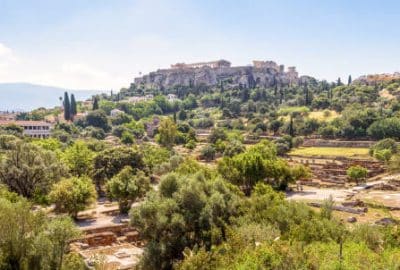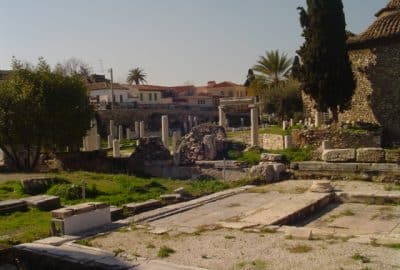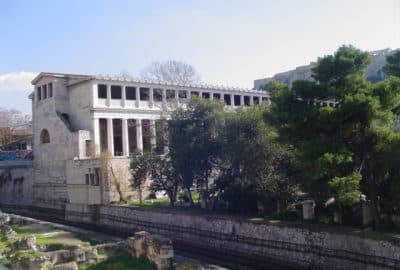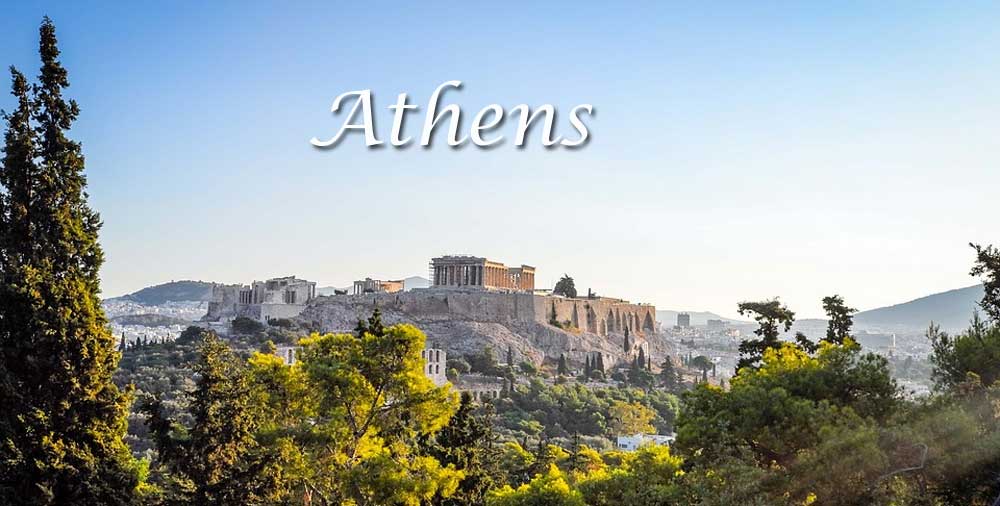The Ancient Agora of Athens

Many of the early buildings date back to around 500 BC, among them the altar of the Twelve Gods which was also an asylum and a starting point for measuring kilometres.
A part of the river Eridanus was boxed then, in order to cross Pananathiaian Street, the central avenue of the Ancient city that crossed the Agora and which was followed every four years by the procession of the great Athenian festival of the same name (Panathinaea) . Stone columns demarcated the public space, while the Church of the Municipality was moved to Pnyx and several of the theatrical events on the southern foothills of the Acropolis. The first building “explosion” begins, shortly after the triumph over the Persians in Salamis and the rise of the Athenian hegemony.
Before the 6th century BC, some of this area was used as a cemetery, but when the Kerameikos became Athens’ principal cemetery, farmers from the countryside brought produce here to sell, and this was Athens’ principal market area.
Over time, this market became a place where most government business took Place and law courts met. Here much of the Social life of clubs went on and athletes exercised, here Socrates strolled and questioned the everyday assumptions of his fellow-citizens, and here St Paul tried to interest the Athenians in Christianity. The Panathenaic Way, which ran from Eleusis to the Acropolis, ran through the Agora, this was the route taken every four years by the celebrants in the Panathenaic Festival which honoured the goddess Athena.
Today, the Agora’s most conspicuous monuments are the 20th-century reconstruction of the 2nd-century AD Stoa of Attalus, the 1 Ith-century Byzantine Church of the Holy Apostles and the well-preserved 5th-century BC Doric Temple of Hephaistos, mistakenly caLled the “Theseion” after Athens’ great hero Theseus.
The temple, which crowns the Iow knoll of Kolonos Agoraios on the west Side of the Agora, was in fact
a temple of Athena and Hephaestus (Theseus is depicted in some of the sculptures). It was probably built c. 449 BC. Thanks to its adaptation and use as a Christian church between the 7 th and 19th centuries AD, it has survived better than any other antique building in Greece. It is a pleasant vantage point from which to orientate oneself in the Agora and, when that proves difficult, simply to take in the splendid view of the Acropolis.
It is reasonable to begin a visit to the Agora near the southwest corner ofthe excavated area, by the boundary stone of the Agora inscribed in lettering of the 5th century BC ‘I am the boundary of the Agora’. The southwest side of the Agora was evidently the first to acquire public buildings. The tholos, evident now only from its circular floor, replaced an earlier building c. 465 BC.
It was headquarters for the 50 prytany or duty officers of the State Council, who had their meals here. The city’s official weights and measures were also stored in the tholos. To the northwest are the foundations of the new bouleuterion or Chamber of the Council, which prepared legislation for the Assembly.
It had semicircular rows of seats, unlike its predecessor to the east (the old bouleuterion), which was subsequently used as a civic archive. Further north the Metroon housed a temple of the Mother of the Gods (Rhea) and additional archives. In the Hellenistic period, the Metroon was embellished with a colonnade and a row of statues, some of whose bases remain.
Nearby is the long base of the Monument of the Eponymous Heroes, which supported ten statues of the heroes after whom the ten tribes of Attica were named. North of the Metroon were the small Archaic temples of Apollo Patroös and one of Zeus and Athena.
In 1931, the American School of Classical Studies in Athens undertook excavations at the Agora. The project was quite difficult as an entire neighborhood of the city had to be expropriated and demolished. Excavations began on May 25 east of the Temple of Hephaestus.
In 1954, the surface of the Agora was cleaned and in 1956 the restoration of the Stoa of Attalos and the renovation of the church of Agios Apostolos were completed. In the 80’s the excavations continued further north, above Adrianou Street where the western end of Poikili Stoa was located. Between 2006 and 2007, three buildings were demolished at this point and the eastern end of the Various Stoa was revealed. Excavations are currently ongoing in this area.
History
During the prehistoric era the Agora was a place of residence and burial, while it was used as a public space. The Ancient Agora of Athens was looted and destroyed many times, first by the Persians in 480 BC, later by the Romans under Sillas in 86 BC, then by the Herulians in 267 AD. and finally the Slavic raiders in 580 AD, when this area was abandoned.
During the 10th century it was allegedly re-inhabited and around 1000 AD the church of the Holy Apostles was built. New destruction followed in 1204 by raiders of Leos Sgouros, the ruler of Nafplion at that time, and new desolation followed.
During the Greek Revolution of 1821, the last disaster occurred. Thus, the 190th century finds the ancient market literally buried under the then densely populated modern Athens, which in 1834 welcomed King Otto to declare the city the capital of the kingdom of Greece.
Excavations

The first excavations of the area of the ancient market began in the 19th century by the Archaeological Society and by German archaeologists. However, the systematic archaeological excavation research started from the American School of Classical Studies in 1931 until 1941, (first period), from 1946 until 1960, (second period), in 1969 (third period) and from 1980 when continues to this day.
Archaeological Museum of the Ancient Agora

This archaeological museum houses and exhibits findings that have come to light from the archaeological excavations that have been made at the archaeological site of the Ancient Agora of Athens.
It extends west and southwest of the museum to the ancient temple of Hephaestus. The exhibition space of the Museum is distinguished inside, which includes four sections-spaces, and the external atrium.
